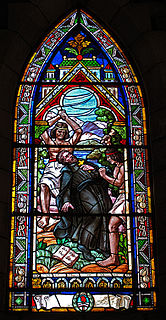Trapananda can refer to:
| This disambiguation page lists articles associated with the title Trapananda. If an internal link led you here, you may wish to change the link to point directly to the intended article. |
Trapananda can refer to:
| This disambiguation page lists articles associated with the title Trapananda. If an internal link led you here, you may wish to change the link to point directly to the intended article. |

A lost city is a settlement that fell into terminal decline and became extensively or completely uninhabited, with the consequence that the site's former significance was no longer known to the wider world. The locations of many lost cities have been forgotten, but some have been rediscovered and studied extensively by scientists. Recently abandoned cities or cities whose location was never in question might be referred to as ruins or ghost towns. The search for such lost cities by European explorers and adventurers in Africa, the Americas, and Southeast Asia from the 15th century onwards eventually led to the development of archaeology.

Alfons Hug is a curator, critic and exhibition organizer.
The City of the Caesars, also variously known as City of Patagonia, the Wandering City, Trapalanda or Trapananda, Lin Lin or Elelín, is a mythical city of South America. It was supposedly located somewhere in Patagonia, in a valley of the Andes between Chile and Argentina. Despite being searched for during the colonization of South America, no evidence proves that it ever existed, although reports of it circulated for two hundred years. In 1766 a Jesuit, Father José García Alsue, explored the area now part of Queulat National Park in Aysén Region, Chile, searching unsuccessfully for the City of the Caesars.

The Taitao Peninsula is a westward projection of the mainland of Chile, with which it is connected by the narrow Isthmus of Ofqui, over which the natives and early missionaries were accustomed to carry their boats between the Moraleda Channel and Gulf of Penas. It is situated in the Aysén del General Carlos Ibáñez del Campo Region and a part of this peninsula is located inside the boundaries of Laguna San Rafael National Park. The Presidente Ríos Lake, with a surface area of 352 square kilometres (136 sq mi), lies in the middle of the peninsula. A southward incurving projection of the outer shoreline of this peninsula is known as Tres Montes peninsula, the most southern point of which is a cape of the same name.

Presidente Ríos Lake is located in the Aysén del General Carlos Ibáñez del Campo Region of Chile. It lies in the middle of the Taitao Peninsula.

Guaitecas Archipelago is an archipelago in the Aisén region. The archipelago is made up of eight main islands and numerous smaller ones. The eight largest islands are from northwest to southeast: Gran Guaiteca, Ascención, Betecoy, Clotilde, Leucayec, Elvira, Sánchez and Mulchey. The islands have subdued topography compared to the Andes, with Gran Guaiteca containing the archipelago's high point at 369 m.
Valdivia is one of the few cities in southern Chile with a more less continuous and well documented history from its foundation in the 16th century onwards.
Trapananda National Reserve is a national reserve of southern Chile's Aysén del General Carlos Ibáñez del Campo Region.

Nicolás Mascardi was an Italian Jesuit priest and missionary in South America in the 17th century. He arrived to Chile in 1651. While active in Araucanía he gained notoriety for the exorcisms he practised among the Mapuches.
Mateo Martinić Beroš is a Chilean historian, politician and lawyer. He has primarily dealt with the history of Magallanes Region. He entered the University of Chile in 1953 studying briefly pedagogy before moving on to study law and then continued his law studies in the Catholic University of Chile. He finally became a lawyer in 1983. From 1964 to 1970 he served as intendant of Magallanes Region.